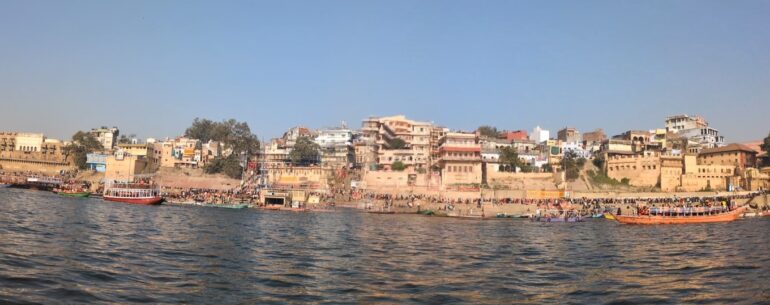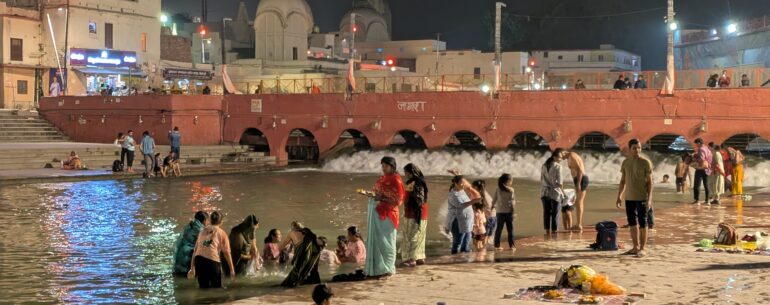Over all these years, the thought of visiting Kumbh Mela has never crossed my mind. For one, I have no firm beliefs on how this pilgrimage will enhance my life. Secondly, I have always been wary of being in the midst of unhygienic conditions, accentuated by lack of adequate arrangements for the millions of pilgrims who visit. So when the initial advertisements started appearing for Maha Kumbh Mela 2025, I ignored it. All the talk of rare alignment of planets and stars that happen once in 144 years, a dip in the sacred sangam washing off one’s sins, new infrastructure being created, etc. etc. did not impress me at all. But what caught my eye was 1 innocuous looking statement –
Availability of Deluxe/luxury accommodation in the specially constructed Tent City.
I did a bit more research and noted that from the Tent City, Triveni Sangam was easily accessible via boat. There would be no need to walk on the regular path to Triveni Sangam that would be teeming with thousands of pilgrims at any point of time. Only for this reason, I decided it was time to experience the Kumbh Mela once. Not as a pilgrim but as a tourist.
Jump to:
How Kumbh Mela is evolving from a religious gathering to a global tourist attraction
Should you visit Kumbh Mela in future as a tourist?
Costs had already skyrocketed when I looked at options
I planned to travel in the first fortnight of February, avoiding the Shahi Snan days. When I started looking at options in mid January to get to Prayagraj, I realised prices had risen 2x to 3x the normal given the huge demand. This is obviously the case all over the world, whenever a popular event takes pace. And Maha Kumbh Mela was no ordinary popular event. No city in the world has hosted 450 million over 45 days(actual final count was 660 million!). Airfares, hotels, rental cars – all were 3-4 times the normal rate.
Direct flights to Prayagraj were very expensive
From Bengaluru, the best way to travel was by air direct to Prayagraj. But the airfares were 3-4 times the normal fares. I was reluctant to pay INR 45k plus for a return ticket to Prayagraj that involved a total flying time of under 5 hours and that too for a trip lasting 2 nights. So I decided to include Ayodhya and Varanasi in the itinerary. It was just as well that the 3 airports at Lucknow, Ayodhya and Varanasi were within a driving distance of under 4 hours from Prayagraj. For some reason, airfares to Ayodhya and Varanasi were much cheaper than direct flights to Prayagraj. So I flew into Ayodhya and flew out of Varanasi. The journey from Ayodhya to Prayagraj and then to Varanasi was obviously by road.
With overcrowded trains and expensive airfares, many Indians preferred to drive to Prayagraj, literally from all over India. It made sense because otherwise, airfare for a family of 5 would have cost over INR 2 lakhs, almost equal to India’s per capita annual income in 2024!
Ayodhya to Prayagraj by road
The road was in a decent condition but it was two lanes for ¾ of the distance till Pratapgarh. Given the traffic density, overtaking was both difficult and dangerous. After Pratapgarh, the road had 4 lanes and was much quicker, despite the traffic.
The worst part was there were no decent restaurants but plenty of dhabas on the way.
Arrival at Prayagraj – hello traffic jams
As I neared Prayagraj, traffic density increased manifold and the average speed dropped to marginally above Zero. There were barricades at several places and traffic was being diverted. I had to cross the Ganga river first and then the Yamuna river before hitting the Arail Ghat road where I had booked accommodation.
Google maps ensured all streets were jammed
I managed to cross the Chandrasekhar Azad bridge over Ganga river fairly quickly and was beginning to believe I might just reach in time for a late lunch. But because of police barricades, my car was forced to move towards old Yamuna bridge while I was still contemplating which was a better option – old or the new Yamuna bridge.
Like me, many others were relying on google maps to guide them and that spread the traffic jams to all the narrower streets as well. Following the google maps, my driver too took a turn away from the main road to the narrower Kydjang road and that’s where I got stuck. To cover a distance of perhaps 3 kms from this road to the old Yamuna bridge, it took me 3 hours. Luckily, there were small grocery shops on the road where I could buy biscuits and beverages. That was my lunch that day! Thankfully, I also managed to strike a conversation with a local who graciously offered access to the toilet located on the terrace of a 3 storied dilapidated house.
Around 4 pm, while still being stuck on the Kydjang road, my driver announced that I would have to find alternate transport as he was getting very late for his next pick up. And moved the car to a side lane! It generally would not have been a problem but for the fact that I was in a group of 4 with luggage! And I was still 10 kms away from the Tent City. But my driver turned out to be quite resourceful and he managed to find an autorickshaw with luggage carrier.
My expected lunch arrival turned into just in time dinner arrival
Thanks to few good Samaritans who had came forward to help clear the traffic jam, I managed to exit Kydjang road by 5pm or so but it took close to an hour to cross the old Yamuna bridge before hitting a police barricade. I was forced to change autos here but the next auto only took me till new Yamuna Bridge where there was another police barricade. I boarded another auto here who thankfully dropped me at the Tent City. The time was 7.30pm. What was supposed to be arrival for lunch turned into just in time arrival for dinner!




Disciplined cab and auto drivers
Amidst all the traffic chaos, what fascinated me was that even the cabs and autos stuck to the lane and did not try to overtake the vehicle in front. I can’t even imagine what would have happened in such a situation in Bengaluru!
As usual, no rules applied to 2 wheelers. Quite unusual for me to see a dedicated lane for the pedestrians on the new Yamuna bridge while motorised vehicles shared the other lane.
6 hours to cover the last 13kms
One car and 3 autos is what took me 6 hours to cover a distance of about 13 kms in Prayagraj! My experience was no different from those of many others who had booked accommodation at the Tent city.
Exiting Prayagraj was quick
My pre-booked cab to Varanasi got cancelled because of the traffic jams and restrictions in Prayagraj. Our hotel managed to book one for us, that I later learnt was 2x the price the cab owner was paid, which itself was 1.5 times the normal fare. The middlemen certainly made merry. Thankfully, the exit was relatively quicker, as I had to head south-east to Varanasi and did not have to cross the rivers again. I saw several parking lots on the way out of Prayagraj towards Saraswathi Hi-Tech city, and people walking with their luggage. Outstation buses had been stopped at Saraswathi Hi-Tech city bus stop. I was actually glad when I finally exited Prayagraj.
Available accommodation
Luxury Tent City
I, like many others, preferred the tented accommodation with a dash of luxury, comfort and proximity to the Sangam. Set up in sector 25 on the sprawling sand banks of River Ganga by various operators including Uttar Pradesh Tourism Development Corporation, IRCTC, Aagman, Evolife and ITDC, the Triveni Sangam was about 3-4 kms away but more importantly, easily accessible.
The Tent City set up for the Mela(all over, not just sector 25) was stated to be the largest of its kind in the world. The length of wooden poles used to erect the Tent city was estimated to exceed 20k kms, more than the distance between Prayagraj and Washington DC! Not sure about the fabric and roofing material used but I am sure that would be equally mind boggling.
Other options
Dormitory style Tented accommodation was available in several locations, either free or for a low price. Set up by state government and NGOs, these tents provided basic amenities including shared washrooms and simple food. The Akharas, certain communities or religious groups too set up accommodation for their followers. The essense of Kumbh Mela pilgrimage is actually community living where pilgrims share tents and spend time in prayers. If you wish to have a genuine Kumbh Mela experience, these are the places to stay.
Other options included hotels, guest houses and homestays. Details were made available on the App developed specifically for Maha Kumbh Mela but could also be easily searched online.
The ITDC Tent City
Advertised as a luxury camp, it cost me INR28k per night per couple for a Deluxe Suite Camp. Inclusive of 3 meals. I had booked about a month in advance and this was the lowest available rate. The tents were quite decent and adequate but definitely not luxury category. Food was average but the staff were quite responsive. Initially, the accommodation(Deluxe Suite Camp) was available for under 20k per night for a couple and given my experience, I think that rate was about reasonable for facilities on offer. Later, given the high demand, the cost per night went up to INR 40k+.
The costs were even higher during the Shahi Snan days.
Some of the luxury accommodation cost INR 1.5 lakhs per night! And they were also running full! That’s some combination of luxury and spirituality. Most of the premium/luxury packages came with benefits, depending on the price paid – all meals, visit to Akharas, yoga lessons, boat ride to the Sangam, and so on. Free pick up and drop from/to airport/railway station was promised but later dropped due to traffic jams. I heard stories of how cars took 10 hours to cover the 18km distance between the airport and Tent City.
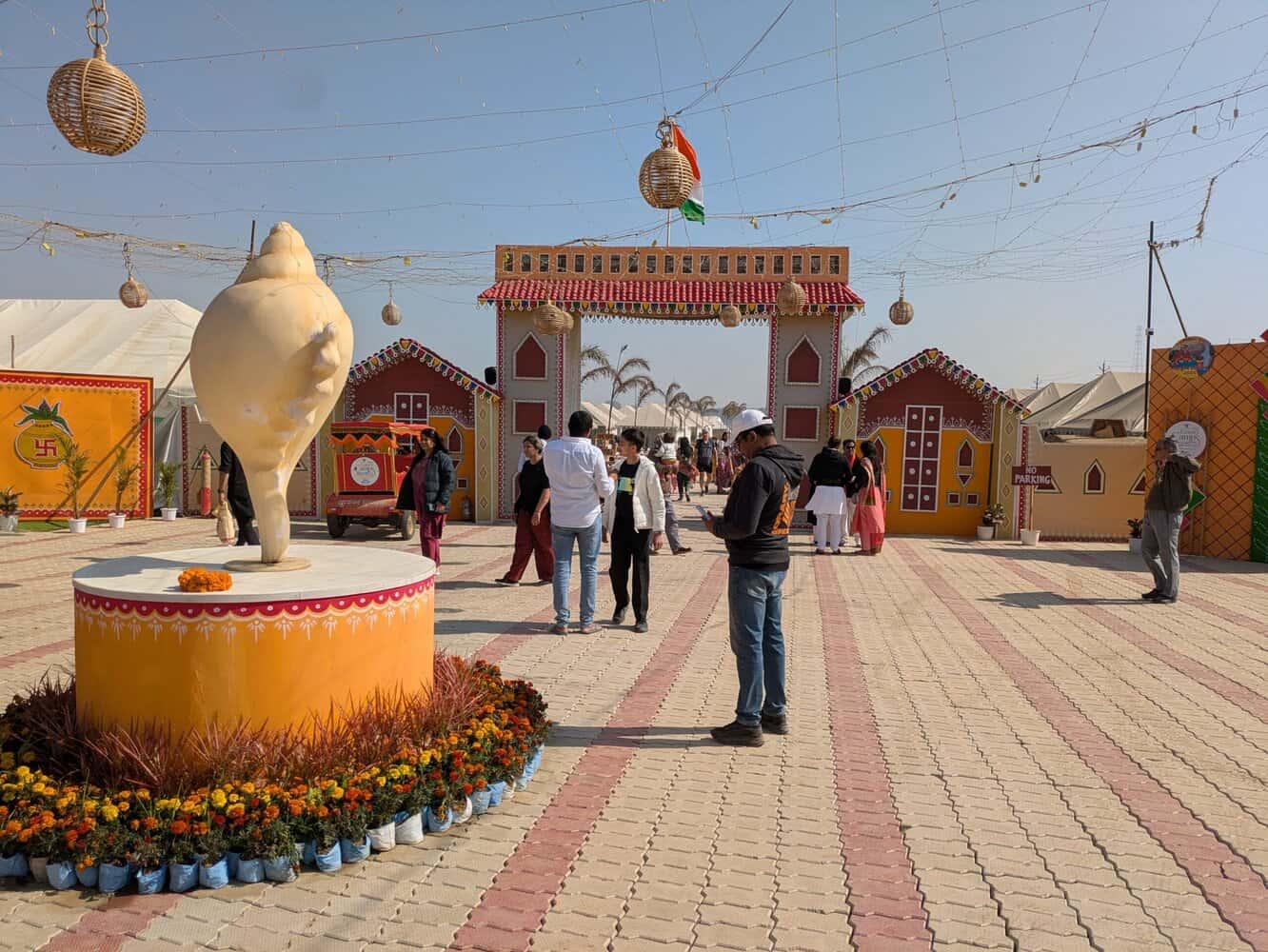


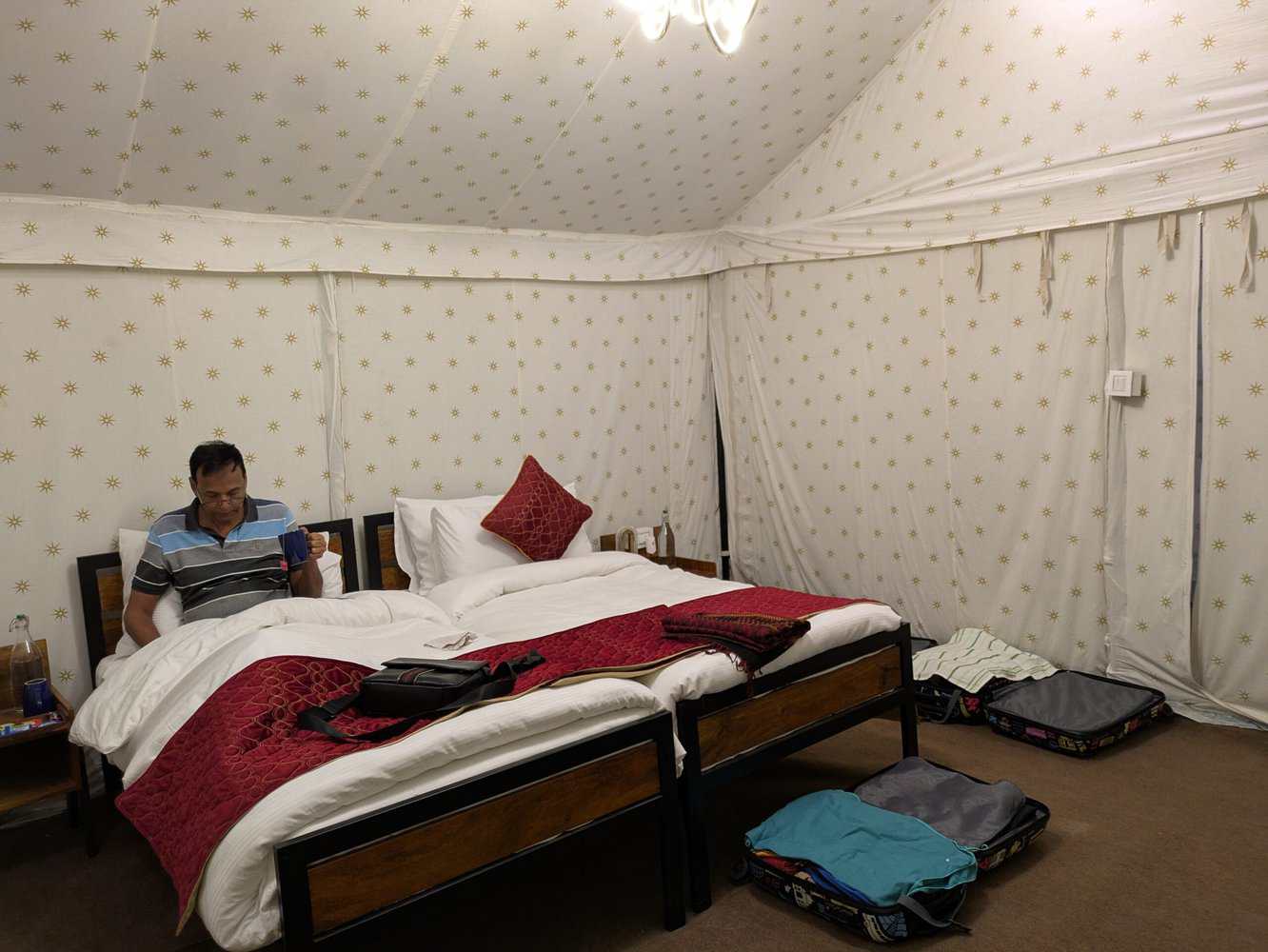
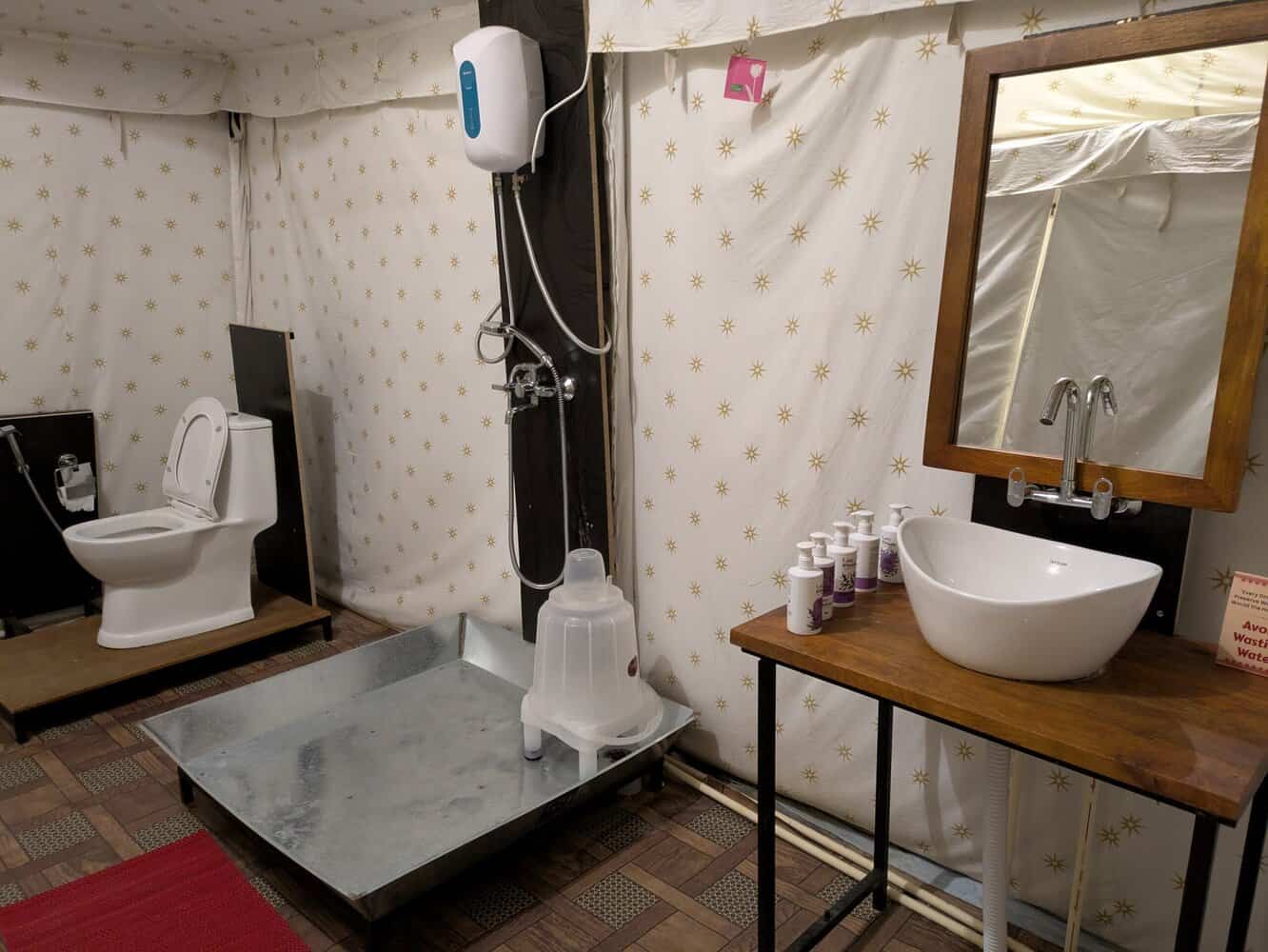

Visit to the Sangam
Over 50 bathing ghats were built so as to ensure everyone did not rush to Triveni ghat/ Sangam ghat. There was one such ghat within walking distance from my hotel but I wanted to see the Sangam. Though I was not inclined for a dip, I was anyway prepared. Initially, I booked a visit to the Sangam through the travel desk at the ITDC Tent City but the guide did not turn up as he was stuck in a traffic jam! The boats to Sangam departed from near Arail ghat on the banks of Yamuna river which I reached via auto(~1.5-2kms) and walk(~1.5-2 kms), a total distance of ~3.5 kms. There were no signages and I had to frequently keep enquiring with the police on duty just to ensure I was going the right way!
On the way, I noticed the bathing ghat and wharf built specifically for VIPs. It appeared so close to the Sangam that I could have swum across.
Massive crowd
From a vantage point, the massive crowds at the Sangam was visible. From that distance, there did not appear to be any vacant space at all. At Arail ghat too, the crowds were huge. And many were looking for rowing boats! There was no dock or quay or jetty or whatever you call it. One had to wade into river water and clamber on board. For elderly, the boats would be dragged as close to the bank as possible. It was a virtual fish market here with people bargaining with boatmen. Reminded me of the outcry system of trading that was prevalent in the Indian Stock Exchanges decades ago!
Seeing the crowds, it was now easy to understand why families get separated.





Boats were not easy to hire without prior booking
After searching for 15 minutes or so, courtesy another devotee, I managed to find a boatman who agreed to take us to Sangam and bring us back for INR2k per person. Luckily, he did not want many passengers as it was tough rowing in the Yamuna river against the current on the return. We were 4 and that was just perfect for him.
The Triveni Sangam was suddenly closed because of crowds and my boatman took me to the small island just opposite the Sangam nose. The river was literally overflowing with boats but my boatman somehow managed to squeeze through. There were quite a few devotees performing elaborate rituals. Change rooms were also available. As the water appeared clean and was flowing at a fair clip, I too decided to take a dip! The water level was no more than 2.5 ft. or so. After a halt of ~15 minutes, it was time to head back. The place we had to go to was right opposite but the boatman said they are only allowed point to point service so I had to return to the boarding point.



Charges were way above official rates
The overall cost was about INR 10k, much less than the INR 15k that the travel desk had demanded. The boat cost INR 2k per person, all cash, and the guy subtly hinted they have to make payoffs to be able to keep the boat running. The official rate was under INR 100 per person one way.
I was back in the hotel in about 3 hours and well in time for lunch. Taking the boat meant I did not have to walk to Triveni Sangam along with thousands of pilgrims. I have heard that pilgrims have walked 5 to 10 kms and sometimes more depending on where their vehicles were parked or from the railway station. Boats were obviously very convenient but meant only for those who could afford it. I saw many people pleading for lower rates but the boatmen would not oblige. Why would they, when the demand was so high?
Other activities
Apart from a visit to the Sangam, there were plenty of other activities on offer to keep both pilgrims and tourists occupied. Cultural programs, photography tours, Akhara tours, Naga experience, Aghori experience, yoga sessions, helicopter tours, singing bhajans and attending religious discourses, private rituals and what not. There is no doubt that the traditional procession of Akharas and the rituals of naga sadhus during Shahi Snan brings lot of color to the Kumbh Mela. But these draw huge crowds that I preferred to avoid.
The Akharas were the prime attraction
The 13 Akharas who participated in the Maha Kumbh Mela were all open to devotees and general public. Some of these Akharas had large spaces where accommodation (from basic to luxury) was available for devotees. I visited 3 of them including the one belonging to Naga Sadhus. Bhajans and regious discurses were regularly held at these Akharas and elsewhere in the ‘Kumbh Mela area’. The sadhus inside the Akharas were generally open to conversations and selfies and would confer their blessings after ‘offerings’, typically cash, were made.
I also visited the newly built and the very impressive Shivalaya Park near the new Yamuna bridge. Dedicated to Lord Shiva, the park has replicas of the 12 Jyotirlingas from around the country, all built using recycled material.
Restaurants were generally crowded
There were plenty of restaurants in the Mela area. Not all appeared neat and clean. And the popular ones were generally crowded. It was good I did not have to step out for meals.
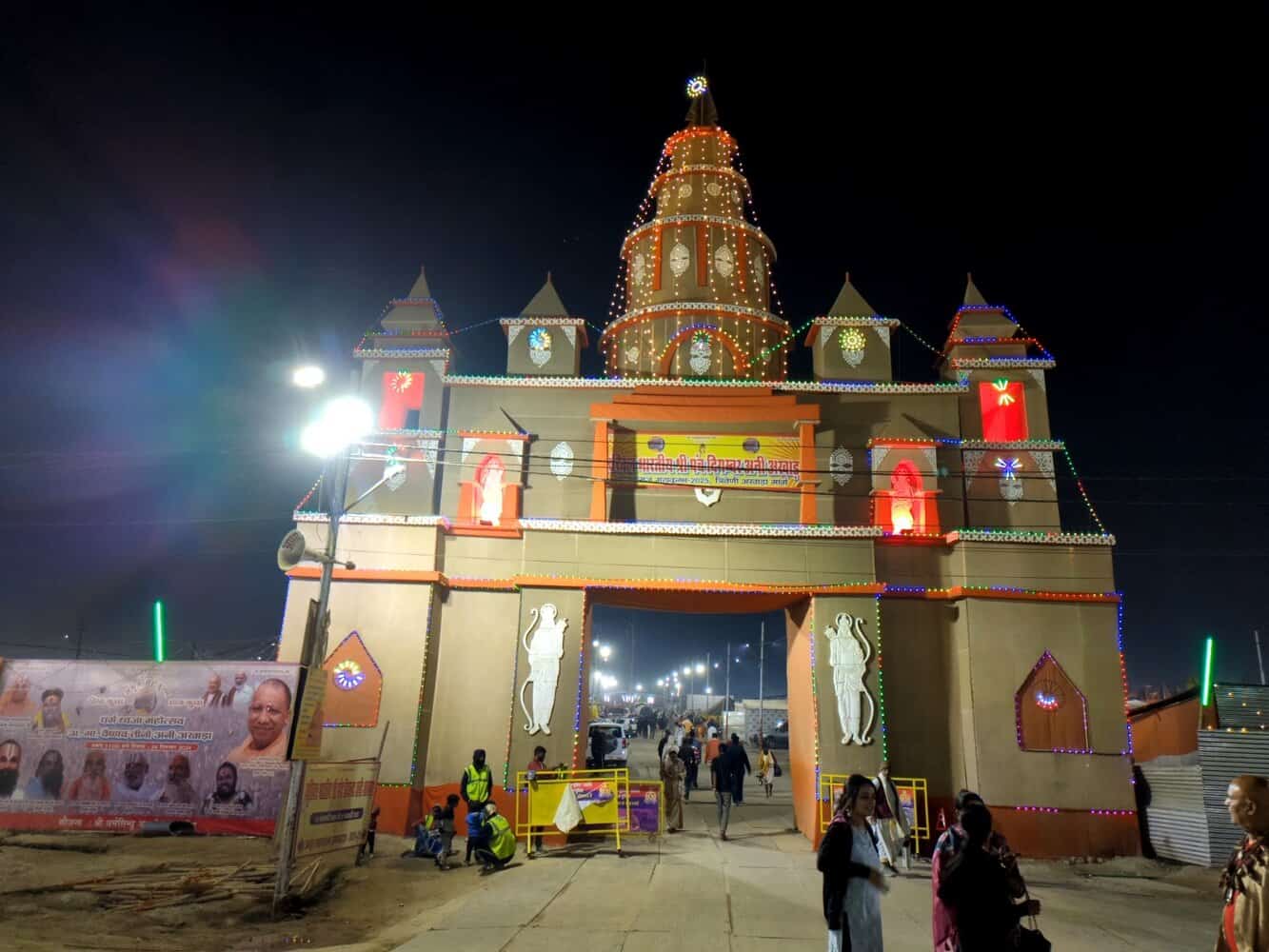
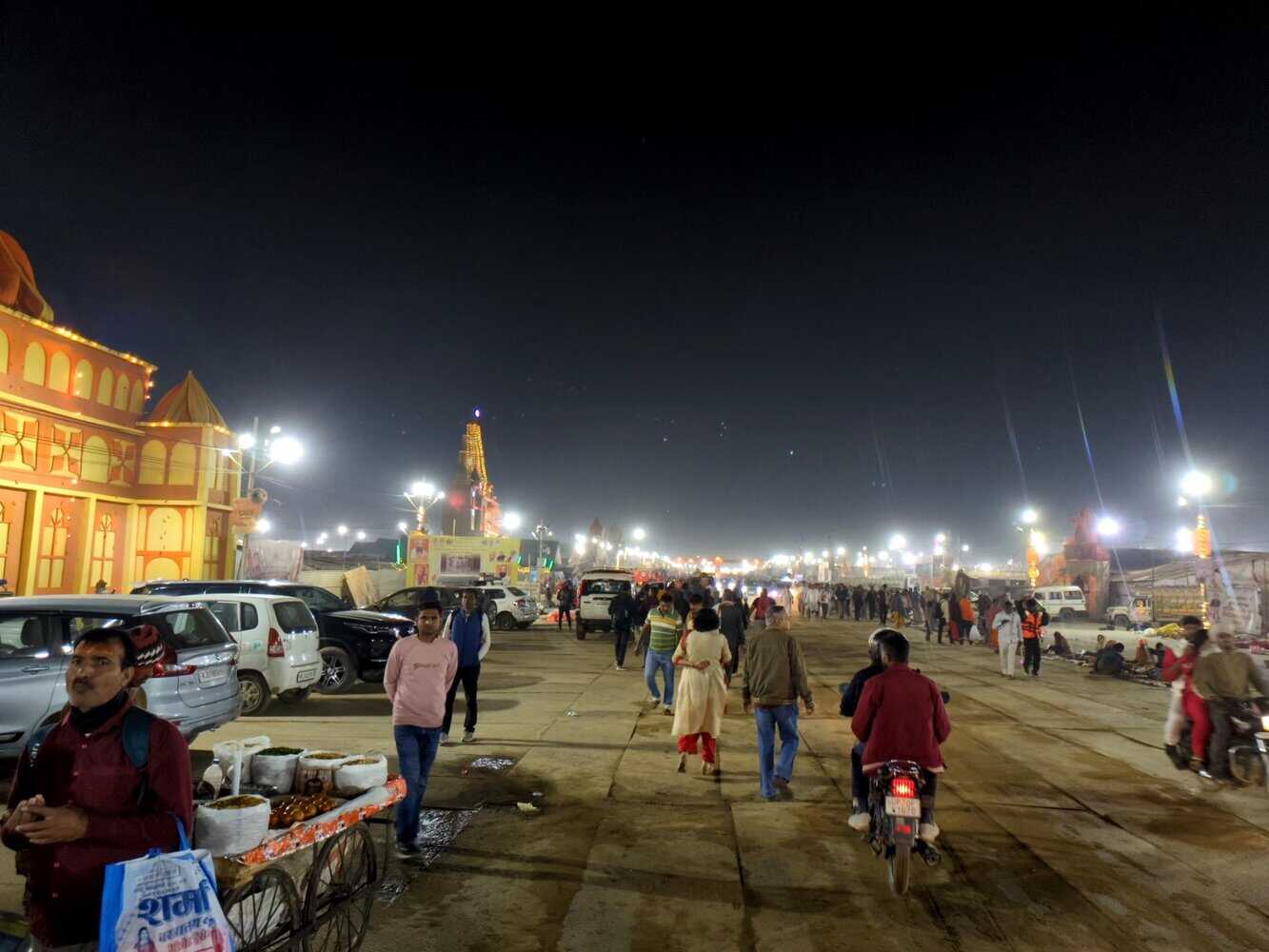



Commuting in the Maha Kumbh Mela area
The entire Maha Kumbh Mela area, spanning 40 sq. kms, was divided into 25 sectors
Temporary pontoon bridges were built to connect various sectors located on either side of the river. E-Autos were generally available though a bit pricey but the fastest way to commute was on motorcycles (bike taxis). Even when there were barricades, motorcycles were often allowed to pass through but not autos. Walking was an option but given the long distances, not a viable option always. Boating was restricted to Sangam visits.
No question of using a 4 wheeler unless escorted by police, a facility available to only VIPs.




Overall organisation of the Mela was praiseworthy
Given that ~660 million people visited Maha Kumbh Mela 2025, it was next to impossible not to have teething issues. Those who drove in their own vehicles had difficulties in parking or had to park several kilometers away from their place of intended stay, traffic jams that would take hours to clear, overflowing public toilets, lack of physical signages, very dusty environment, vendors and middlemen making a fast buck but all these dwarf in the backdrop of the massive arrangements. The State Government certainly deserves appreciation.
Was the atmosphere spiritually charged as claimed?
I read several comments stating the atmosphere at the Mela was electrifying and spiritually charged. Honestly, I felt so such thing! Maybe involvement in processions, rituals, Shahi Snan, bhajans etc. may have made a difference. But yes, the atmosphere at the Mela was certainly different. Despite the huge crowd at the ghats, it was not noisy at all. No one seemed to be in a hurry to get anywhere. Every one appeared to be in a pleasant mood and willing to help.
As for spiritual experience, I found that the ghats of Varanasi, especially Manikarnika and Harishchandra, naturally evoked a sense of stillness and inner contemplation.
The faith and devotion of the pilgrims is to be seen to be believed. Thousands of families came from villages and smaller towns, walking several kilometers with their luggage, some arriving in the night and sleeping/staying awake on the bank of the river so as to take a dip before sunrise, many with limited cash in their pockets and hence inability to afford accommodation, auto rides and boat rides. Many just hung around, attending bhajans and religious discourses. But I am sure almost all would have had strong religious beliefs to undertake this pilgrimage while few would have come to escape from the drudgery of daily life. Good part was that free food and free accommodation was made available to all such people who otherwise could not afford it.


Kumbh Mela is turning into a tourist attraction with huge economic ramifications
Kumbh mela is a mixture of myths, history, astrology and abiding faith of people. It is essentially a pilgrimage, a religious congregation which in the earlier days would be attended by pilgrims, sadhus and religious leaders. Over the years, this religious gathering is evolving into a global tourist attraction. Look at these indicative statistics on the number of attendees.
2013 – 120 million(Prayagraj)
2015 – 10 million(Nashik)
2016 – 60 million(Ujjain)
2019 – 250 million(Prayagraj)
2021 – 9 million(Haridwar, during Covid pandemic)
2025 – 663 million, with over 3 million foreign tourists(Prayagraj).
In comparison, the Rio carnival at Rio De Janeiro attracts under 10 million visitors over 5 days while the Oktoberfest in Munich attracts 7 million visitors over 2 weeks. The annual Haj attracts 2.5 million pilgrims.
A confluence of faith and commerce
Maha Kumbh Mela 2025 was a fantastic cross between faith and commerce, technology and tradition, with several innovations designed to enhance visitor experience. A great example of how a religious event can fuel economic growth. The total turnover from goods and services has been estimated to be in excess of INR 3 lakhs crores(USD 36 billion for simplicity). The UP State Government expects to earn INR 55k crores from taxes etc.(against an expenditure of ~INR 12 k crores). Apart from established companies, many local entrepreneurs and service providers were part of the entire eco-system who benefited. The overall economic impact of Maha Kumbh Mela 2025 is huge.
But does a genuine pilgrim care for any of this? I doubt.
Should you plan a visit to the Kumbh Melas in future?
Before visiting the Kumbh Mela, I used to wonder if tourists like me are diluting the authenticity of Kumbh experience. Would it have been better for both the pilgrims and the locals if the luxury Tent City had not been set up at all? But one visit and all my doubts vanished. It was quite obvious that one part of Kumbh Mela involves the pilgrims and the other part, tourists like me. With curated experiences for tourists, the second part has a far bigger economic impact, across industries and on the local economy, something that appears to be welcomed as of now. Whatever little conversations I had with the locals, they did talk about hardships but none said anything about stopping the flow of tourists. Maybe they believed every tourist was a pilgrim!
If you are like me with no firm religious beliefs, there is no real need to experience Kumbh Mela. But if wish to check out what it feels like to be in the midst of the largest gathering in the world, do make a visit but be ready for some inconveniences. Try not to drive in your vehicle, pack modestly, be prepared to pay a big premium to normal prices and carry some extra cash. From all accounts, you will be most welcome!
Related posts
A day in Ayodhya(to be updated)
4 days in Varanasi(to be updated)

